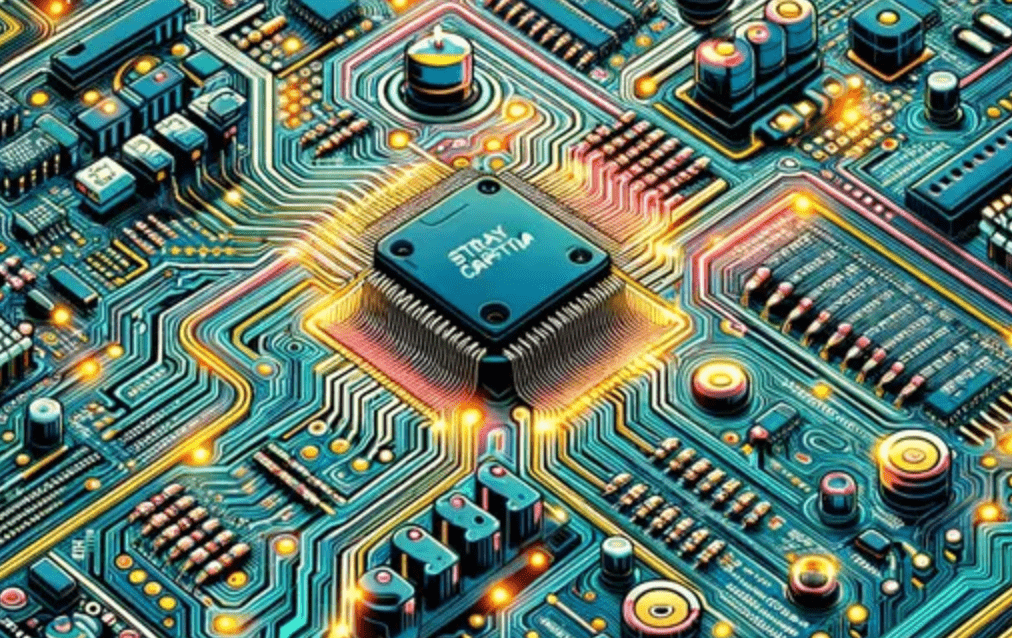Stray capacitance in PCB layouts can degrade signal integrity and performance, particularly in high-frequency and precision analog circuits. Understanding and minimizing stray capacitance is therefore vital for designers aiming to optimize their PCBs for superior performance, ensuring that devices operate reliably and according to their intended specifications.

Stray capacitance in PCB layouts refers to the unintentional capacitive effects that occur between conductive parts of the board, such as between traces, components, and ground planes. This phenomenon is particularly troublesome in high-frequency and precision analog circuits, where it leads to signal distortion, noise introduction, and overall degradation of circuit performance. The main contributors to stray capacitance include the layout and proximity of conductive parts, the dielectric properties of the PCB material, and the arrangement of components and ground planes, all of which can inadvertently foster capacitive coupling between circuit elements.
The basic principle behind capacitance is calculated by the formula C = Q/V, where C is the capacitance, Q is the charge stored, and V is the voltage across the capacitor. This equation highlights the core function of a capacitor: to store electrical charge at a specific voltage. In the context of PCB design, stray capacitance arises unintentionally due to the layout and proximity of conductive elements, acting like miniature, unwanted capacitors distributed across the board.
While the specific formula C= ϵA/D elaborates on how capacitance in a PCB (or any capacitor) depends on the physical characteristics and materials of the system. Here's a breakdown of each component in this formula:
C is the capacitance, measured in Farads (F).
ε (epsilon) represents the permittivity of the dielectric material separating the conductors.
A is the area of overlap between the conductive elements, measured in square meters (m²).
D is the distance between the conductive elements, measured in meters (m).
This relationship implies that capacitance increases with a larger area of overlap between conductors and a higher dielectric constant, but decreases as the distance between conductors increases. In PCB design, adjusting these variables can help manage and minimize stray capacitance. For example, increasing the distance between traces or using materials with a lower relative permittivity can reduce unwanted capacitive effects.
Reducing stray capacitance in PCB design involves a combination of layout techniques, component placement strategies, and careful selection of materials. Here are key strategies for minimizing stray capacitance, enhancing circuit performance, and ensuring signal integrity:
Space traces, pads, and components further apart to reduce capacitive coupling. The capacitance between two conductors is inversely proportional to the distance between them.
Optimizing trace geometry is a crucial strategy in PCB design to reduce stray capacitance, which can adversely affect signal integrity, especially in high-frequency circuits. This optimization involves two main approaches: decreasing trace width and minimizing trace length.
Decrease Trace Width: For high-frequency signals, use narrower traces to reduce the area facing adjacent traces or planes, thereby decreasing capacitance.
Minimize Trace Length: Shorter traces have less area for capacitive coupling, reducing overall stray capacitance.
Using shielding techniques is an effective way to reduce stray capacitance and protect sensitive circuits from interference in PCB design. These techniques involve strategic placement of ground planes and the use of guard traces.
Ground Planes: Implement ground planes effectively to shield sensitive traces from potential capacitive coupling with other signals.
Guard Traces: Place grounded guard traces alongside high-impedance or sensitive signal traces to mitigate capacitive coupling.
Design the layer stack-up to place ground planes adjacent to signal layers, which can help in shielding and reducing the effective area for capacitance formation. Use pre-planning tools and simulations to optimize stack-up for minimal stray capacitance.
Traces running parallel to each other over significant lengths increase capacitive coupling. Design your layout to avoid parallel routing of sensitive or high-speed traces, especially over long distances.
Proper impedance matching across the PCB can reduce reflections and the need for long traces, which can indirectly help in minimizing stray capacitance. Use impedance calculators and simulation tools to design your traces and stack-up accordingly.
For high-frequency circuits, consider using microstrip or stripline configurations, which can help in controlling both impedance and stray capacitance by their geometric configurations.
By integrating these strategies into the PCB design process, designers can significantly reduce stray capacitance, ensuring that the final product meets the desired specifications for performance and reliability.
Stray capacitance refers to the unintentional capacitance that exists between any two conductive parts of a circuit when they are separated by an insulating material. This can include capacitance between traces, leads, components, or between a trace and a ground plane.
While Parasitic capacitance is a broader term that encompasses all types of unintended capacitance within a circuit, including stray capacitance. It refers to capacitance that parasitically exists alongside the intended circuit elements and can degrade circuit performance.
Scope: Stray capacitance is a type of parasitic capacitance with a focus on the unintended capacitance caused by the layout and physical configuration of the circuit. Parasitic capacitance has a broader definition, including all unintended capacitances that affect circuit performance.
Source: Stray capacitance emphasizes the geometric and spatial aspects, while parasitic capacitance includes these as well as capacitances inherent to the components and materials.
Effectively managing stray capacitance is pivotal to achieving high-performance and reliable PCB designs, especially in complex high-frequency and precision analog applications. By leveraging advanced PCB design software, such as OrCAD PCB Designer, designers can harness powerful tools for layout, simulation, and analysis, ensuring their circuits are optimized for minimal stray capacitance and uncompromised signal integrity.
If you're looking to elevate your PCB design process and ensure your projects are free from the adverse effects of stray capacitance, Contact us to learn more and take the first step towards optimizing your PCB designs for peak performance.
By continuing to use the site you agree to our privacy policy Terms and Conditions.
Recruit global agents and distributors Join us